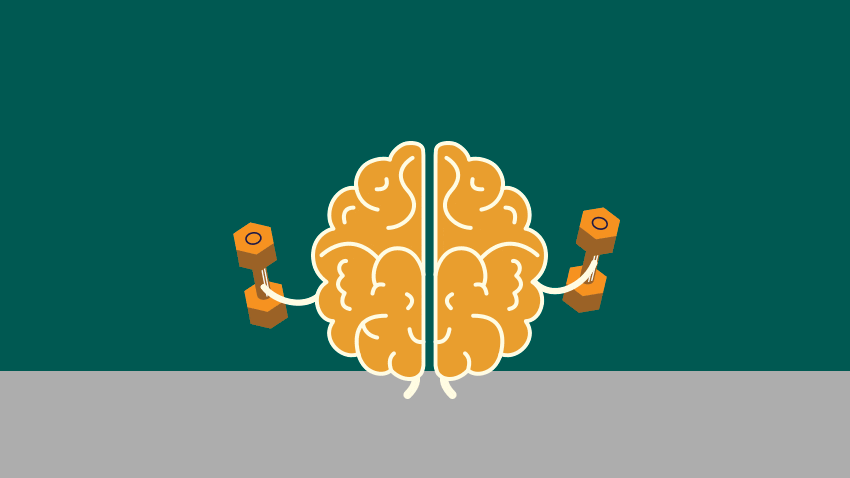Researchers are investigating whether physical activity has beneficial effects on age-related declines in cognitive function.
7:00 AM
Author |

Most people know that regular exercise can keep a body looking and feeling young.
What about the brain?
MORE FROM THE LAB: Sign up for our weekly newsletter
"There has been a wealth of evidence from past studies that physical activity has beneficial effects on neurocognitive functions, such as memory and regulatory control," says Mark Peterson, Ph.D., M.S., FACSM, assistant professor of physical medicine and rehabilitation at Michigan Medicine. "Essentially, those studies show that the physical activity alters the brain's aging trajectories to preserve cognitive health."
Peterson and colleagues were recently awarded a two-year grant from the University of Michigan's Exercise & Sport Science Initiative to further examine the role physical activity plays on the brain. The grant is one of four recently awarded by the U-M initiative to study physical activity.
A shortage of comprehensive analyses propelled the new effort.
"Those previous studies did not examine the effects in a large cohort," Peterson says. "We're hoping this study fills that knowledge gap and can validate and extend the previous claims."
Peterson and his U-M colleagues in psychiatry, Chandra Sripada, M.D., Ph.D., and computer science, Jenna Wiens, Ph.D., will obtain and study the cohort and data from the United Kingdom Biobank.
"The U.K. Biobank is the world's largest prospective epidemiological study," Peterson says. "It gathers extensive questionnaires and physical and cognitive measures from 500,000 participants."
"We'll be incorporating deep-learning techniques to predict brain age from raw neuroimaging, and will examine the independent effects of objectively measured physical activity on brain age and cognitive function in the cohort," he adds.
Peterson, also a member of the U-M Global Research, Education and Collaboration in Health and Institute for Healthcare Policy and Innovation, spoke more about the study.
What made you decide to research this topic?
Peterson: There is a wealth of evidence that in middle-age and older individuals, physical activity has beneficial effects on neurocognitive functions (working memory, declarative memory, attention, etc.).
It has been conjectured that physical activity produces these effects by altering typical aging trajectories of critical brain circuits that underlie major cognitive functions. However, at this time, there have been no rigorous, large-scale studies to examine the effects of objectively measured physical activity on aging trajectories of the human brain.
What will be your focus?
Peterson: We expect to better understand the role of physical activity participation and dosage on deviations in brain health and cognitive function. It is now known that distinct brain circuits associated with specific neurocognitive functions exhibit distinct trajectories of change during aging.
SEE ALSO: For Geriatric Falls, 'Brain Speed' May Matter More Than Lower Limb Strength
Thus, we will generate maps of neurotypical change in order to assess how physical activity influences an individual's position along the expected aging trajectories. To generate these maps of neurotypical change, we will apply deep-learning methodologies.
How will your work differ from prior research efforts?
Peterson: Previous studies have used machine learning to predict brain age in various disease processes (e.g., Alzheimer's). However, this work will be the first ever to use deep-learning algorithms to better understand deviations in brain age by physical activity and functional profiles in otherwise healthy middle-aged adults.
Moreover, we will go substantially beyond previous studies in multiple ways:
-
The inclusion of participants from the world's largest epidemiologic study
-
Physical activity will be measured objectively (and not just by self-report)
-
Utilization of multimodal imaging (not just imaging of brain volume)
-
Examination of circuit-specific aging trajectories
-
Employment of advanced deep-learning methods for constructing brain age trajectories
-
Analyzing complex relationships between physical activity, brain aging and cognitive functioning to gain evidence about potential causal pathways
What are you hoping to accomplish?
Peterson: Our proposed study is poised to decisively answer two critical unanswered questions: What is the effect of physical activity on circuit-specific brain aging, and does this effect mediate the effect of physical activity on improved cognitive functioning?
We anticipate that this work will lead to subsequent cross-disciplinary collaboration within U-M to secure federal funds for prospectively studying the effects of exercise for physical and cognitive health preservation or improvements in adults with and without deficits.
Who might benefit most from this research?
Peterson: This work is poised to inform public health and clinical audiences regarding the benefits of exercise and physical activity on brain health. Therefore, we expect that our findings will support and bolster the movement for integrating recommendations for exercise in clinical care.

Explore a variety of health care news & stories by visiting the Health Lab home page for more articles.

Department of Communication at Michigan Medicine
Want top health & research news weekly? Sign up for Health Lab’s newsletters today!





